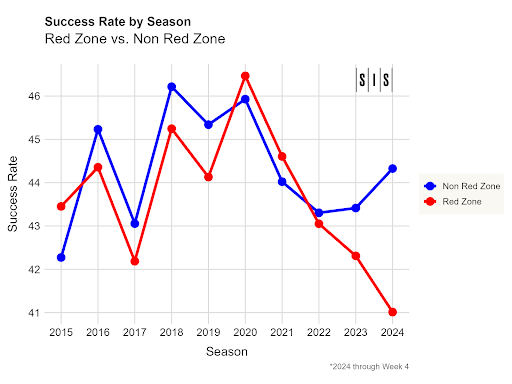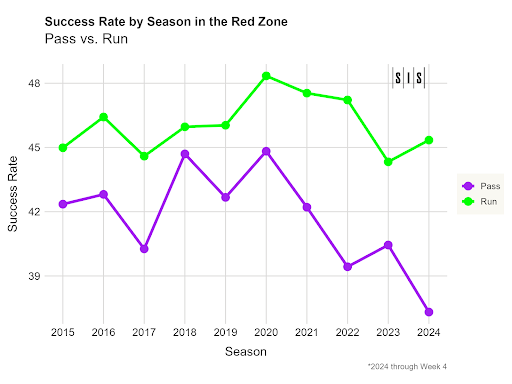You have probably heard this before, but once again, scoring in the NFL is down. At a measly 42.3 points per game, the league is scoring at the lowest rate in the last 10 years. This is a (disturbing?) trend that has continued in 2024 after we also saw drops in 2023 (43.5) and 2022 (43.8).
What is contributing to the dearth of scoring across the league? Some are arguing it is shoddy quarterback play, others are saying play calling has gotten worse, and some are saying defenses have adapted too much and are calling for the banning of basic principles (looking at you, Mel).
All of these have a legitimate argument to be the winner. However, looking at these items as a whole is very complex and rather difficult to evaluate. What if we could evaluate these hypotheses by shrinking the field by 80 yards and still account for nearly 70% of all scoring plays? Oh wait, we can!
By looking at red zone success, we can see whether or not the decrease in efficiency is even more stark than that of non-red zone plays. As it turns out, the overall trend correlates heavily with the red zone trend.
Overall Red Zone vs. Non Red Zone

Over the past two seasons, red zone success rate decreased year-over-year while non red zone success rate increased. These are the only two seasons where this occurs over the last ten; otherwise, these success rates generally have mirrored each other.
Additionally, this season and the previous two are in the bottom four of red zone success, with 2017 coming in as the other season. There is a clear trend in decreasing efficiency in the red zone, one that does not hold true for non red zone plays.
Why does this trend exist? What has happened in the last few seasons relative to non red zone plays? To help answer, let’s look at the pass/run splits when in the red zone.
Pass vs. Run
Generally speaking, it is hard to convince someone in today’s game that running the ball is more efficient than passing. In fact, there isn’t much of an argument, as passes have a success rate of 46.7% while runs are at 40.5% over the past decade. This trend holds on plays in the majority of the field.
However, the red zone is a different story. Running the ball has resulted in a 46.2% success rate, while passing is only at 42.1%. When there is less space to work with and the field shrinks, gaining yards on the ground becomes the preferred method of advancement.

Breaking out the splits by season and play type, we see that running in the Red Zone overwhelmingly is the more efficient option, with only two running seasons coming below the top passing season. Additionally, there were more pass plays in all of the seasons, suggesting that play calling can improve at the basic run or pass decision.
So far in 2024, passing has been the worst it has been in the past decade at a putrid 37.3% success rate. Rushing is at the middle of the pack at roughly 45.3% when strictly looking at rushing seasons.
The ratio of pass plays to run plays is at 1.15 in 2024, which is in line with what it has been the past few seasons (1.09 in 2023, 1.15 in 2022). More pass plays is not the problem, but rather what is happening on those plays.
No Fly Zone
On-Target Throw Percentage
| Season | Red Zone On-Target Percentage | Non Red Zone On-Target Percentage |
| 2018 | 75.0% | 79.7% |
| 2019 | 73.1% | 76.5% |
| 2020 | 74.7% | 78.9% |
| 2021 | 72.7% | 77.2% |
| 2022 | 71.3% | 75.3% |
| 2023 | 71.6% | 73.9% |
| 2024 | 68.5% | 78.7% |
Accuracy in the red zone has been on a steady decline since 2016 and has hit the sub 70% marker for the first time through four weeks in 2024. Specifically, crossing routes, flat routes, hook routes, and vertical routes are all at their lowest accuracy levels during this time. Given this applies to multiple routes with different depths, we are unable to point at specific increases or decreases in targeted routes that solely contribute to the drop in percentages, but rather a phenomenon that is happening at a general level in the red zone.
On the contrary, accuracy on non red zone passes has increased in 2024. So much so that we haven’t seen these levels since 2020. Only the post route is at its lowest level of accuracy in this time period outside of the red zone.
There is a clear struggle on making tighter throws when it matters most and is the difference between success in the red zone and the other areas of the field. Also, this phenomenon isn’t a result of making more difficult throws in the red zone than in the open field, as this holds when looking at Expected On-Target Percentage as well (which accounts for factors like throw depth and pressure). Defenses are allowing the completions underneath in exchange for not allowing the big play (see 2 High discourse), and are able to tighten in the red zone to prevent points on the board.
Conclusion
Overall, success in the red zone has declined faster than success in non red zone situations. Specifically, the accuracy of quarterbacks has dropped off a cliff in the red zone but has increased in non red zone situations. Running the ball leads to more success when the field gets smaller, so teams that can do that successfully have an advantage.
Scoring is hard, so it is imperative to take advantage of the opportunities given when in the red zone. Everyone loves the downfield pass, but when it comes down to it, success in the red zone relies on more balance than the rest of the field.

